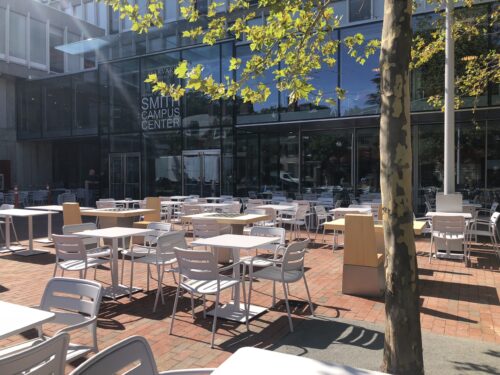On Monday, October 5, Harvard University started the phased opening of campus social spaces of Richard A. and Susan F. Smith Campus Center. As of the partial reopening of the campus for the fall session, social spaces have been, by and large, closed in an effort to reduce large-scale socialization. In the face of the current pandemic, large gatherings pose a serious threat to public health, and the University has responded by implementing socialization rule strictly limiting the size of gatherings and heavily restricting indoor interactions of any kind. As a result, for the past several months, the massive pane glass windows have looked in on nothing but unoccupied benches and empty halls.
Despite finally opening the community, the Smith Campus Center bears little resemblance to the Campus Center of the past. Access to study spaces is by appointment only, and the building is heavily de-densified. The massive high celling hallway, which once served as a bustling pedestrian thruway for moving between the River Houses and the Yard, is now eerily silent, devoid of the sounds of footsteps and careless chatter that once permeated the air. The cafés and restaurants sit empty, as food and drink is not permitted to prevent visitors from removing their masks. The open plan study spaces seem uncomfortably vast and empty. What little evidence of human presence there is comes from the new safety practices implemented to ensure that this opening does not lead to a new wave of infections, with University employees patrolling the area to ensure that social distancing and mask protocols are being strictly followed and surfaces are regularly disinfected to prevent indirect infection.
The bright wood floors and natural light cannot keep the Smith Campus Center of today from seeming rather cold and unwelcoming, but it does provide a safe and climate controlled space for students to work while escaping the confines of their dorms. Allowing indoor socialization of any kind is a major step forward in the process of reopening University facilities, even if the scope is extremely limited. At the same time, this does little to reduce the overwhelming lack of face-to-face socialization in University facilities.
The partial opening of campus social spaces follows an extremely successful fall reopening. As of June 1, only 77 new positive cases have been identified in the community, with only nine of those being undergraduate students. As of October 22, in the last seven days, there have only been six new cases, consisting of two graduate students and four faculty or staff members. This speaks to the overall effectiveness of Harvard’s extremely strict reopening plan, which has effectively prohibited indoor fraternization by preventing students from entering each other’s rooms and closing social spaces, libraries, and classrooms. The extremely low rate of infection (circa 0.04% as of the time this was written) has emboldened to administration to make certain allowances to improve quality of life, such as the partial reopening of the Smith Campus Center and the resumption of hot meal service. Even so, Harvard’s policies remain well in excess of the precautions recommended by the CDC. It is possible that, if current trends hold, we may see increased allowances made for socialization within the Harvard community.
Though the prevention measures have been effective on campus, the nation as a whole is seeing an increasing number of new cases, and it is possible that this could ultimately lead to Harvard keeping current socialization guidelines in place or even instituting new ones. While so far this has been successful, it is possible the maintaining this policies long term could lead to students socializing outside the relatively low risk bubble of the Harvard campus and outside of proper safety protocols and oversight. While on-campus socialization could allow an outbreak to rapidly spread through the community, off-campus socialization increases the chance of a student contracting the virus from an outside source and before slowly spreading it among the student body during the asymptomatic period. Despite the risks, the advantages of being able to supervise interactions and preform contact tracing may make increased socialization in University-controlled common spaces a worthwhile endeavor.
Chidambaram Thillairajah ’21 (cthillairajah@college.harvard.edu) writes Forum for the Indy.
Photo by Marissa Garcia ’21.

